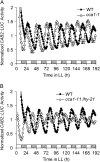CIRCADIAN CLOCK ASSOCIATED1 and LATE ELONGATED HYPOCOTYL function synergistically in the circadian clock of Arabidopsis
- PMID: 19218364
- PMCID: PMC2689956
- DOI: 10.1104/pp.108.133272
CIRCADIAN CLOCK ASSOCIATED1 and LATE ELONGATED HYPOCOTYL function synergistically in the circadian clock of Arabidopsis
Abstract
The circadian clock is an endogenous mechanism that coordinates biological processes with daily and seasonal changes in the environment. Heterodimerization of central clock components is an important way of controlling clock function in several different circadian systems. CIRCADIAN CLOCK ASSOCIATED1 (CCA1) and LATE ELONGATED HYPOCOTYL (LHY) are Myb-related proteins that function in or close to the central oscillator in Arabidopsis (Arabidopsis thaliana). Single mutants of cca1 and lhy have a phenotype of short-period rhythms. cca1 lhy double mutants show an even shorter period phenotype than the cca1 single mutant, suggesting that CCA1 and LHY are only partially functionally redundant. To determine whether CCA1 and LHY act in parallel or synergistically in the circadian clock, we examined their expression in both light-grown and etiolated seedlings. We have shown that LHY and CCA1 bind to the same region of the promoter of a Light-harvesting chlorophyll a/b protein (Lhcb, also known as CAB). CCA1 and LHY can form homodimers, and they also colocalize in the nucleus and heterodimerize in vitro and in vivo. In Arabidopsis, CCA1 and LHY physically interact in a manner independent of photoperiod. Moreover, results from gel filtration chromatography indicate that CCA1 and LHY are present in the same large complex in plants. Taken together, these results imply that CCA1 and LHY function synergistically in regulating circadian rhythms of Arabidopsis.
Figures







Similar articles
-
Posttranslational regulation of CIRCADIAN CLOCK ASSOCIATED1 in the circadian oscillator of Arabidopsis.Plant Physiol. 2009 Jun;150(2):844-57. doi: 10.1104/pp.109.137414. Epub 2009 Apr 1. Plant Physiol. 2009. PMID: 19339503 Free PMC article.
-
A self-regulatory circuit of CIRCADIAN CLOCK-ASSOCIATED1 underlies the circadian clock regulation of temperature responses in Arabidopsis.Plant Cell. 2012 Jun;24(6):2427-42. doi: 10.1105/tpc.112.098723. Epub 2012 Jun 19. Plant Cell. 2012. PMID: 22715042 Free PMC article.
-
Reciprocal regulation between TOC1 and LHY/CCA1 within the Arabidopsis circadian clock.Science. 2001 Aug 3;293(5531):880-3. doi: 10.1126/science.1061320. Science. 2001. PMID: 11486091
-
MYB transcription factors in the Arabidopsis circadian clock.J Exp Bot. 2002 Jul;53(374):1551-7. doi: 10.1093/jxb/erf027. J Exp Bot. 2002. PMID: 12096093 Review.
-
The role of CCA1 and LHY in the plant circadian clock.Dev Cell. 2002 May;2(5):516-8. doi: 10.1016/s1534-5807(02)00184-3. Dev Cell. 2002. PMID: 12015957 Review.
Cited by
-
Transcriptomic Analysis of Radish (Raphanus sativus L.) Spontaneous Tumor.Plants (Basel). 2021 May 3;10(5):919. doi: 10.3390/plants10050919. Plants (Basel). 2021. PMID: 34063717 Free PMC article.
-
SDC mediates DNA methylation-controlled clock pace by interacting with ZTL in Arabidopsis.Nucleic Acids Res. 2021 Apr 19;49(7):3764-3780. doi: 10.1093/nar/gkab128. Nucleic Acids Res. 2021. PMID: 33675668 Free PMC article.
-
ELF3 recruitment to the PRR9 promoter requires other Evening Complex members in the Arabidopsis circadian clock.Plant Signal Behav. 2012 Feb;7(2):170-3. doi: 10.4161/psb.18766. Epub 2012 Feb 1. Plant Signal Behav. 2012. PMID: 22307044 Free PMC article.
-
CIRCADIAN CLOCK-ASSOCIATED1 Controls Resistance to Aphids by Altering Indole Glucosinolate Production.Plant Physiol. 2019 Nov;181(3):1344-1359. doi: 10.1104/pp.19.00676. Epub 2019 Sep 16. Plant Physiol. 2019. PMID: 31527087 Free PMC article.
-
Structure and character analysis of cotton response regulator genes family reveals that GhRR7 responses to draught stress.Biol Res. 2022 Aug 16;55(1):27. doi: 10.1186/s40659-022-00394-2. Biol Res. 2022. PMID: 35974357 Free PMC article.
References
-
- Alabadí D, Oyama T, Yanovsky MJ, Harmon FG, Más P, Kay SA (2001) Reciprocal regulation between TOC1 and LHY/CCA1 within the Arabidopsis circadian clock. Science 293 880–883 - PubMed
-
- Alabadí D, Yanovsky MJ, Más P, Harmer SL, Kay SA (2002) Critical role for CCA1 and LHY in maintaining circadian rhythmicity in Arabidopsis. Curr Biol 12 757–761 - PubMed
-
- Anderson SL, Kay SA (1997) Phototransduction and circadian clock pathways regulating gene transcription in higher plants. Adv Genet 35 1–34 - PubMed
-
- Anderson SL, Teakle GR, Martino-Catt SJ, Kay SA (1994) Circadian clock- and phytochrome-regulated transcription is conferred by a 78 bp cis-acting domain of the Arabidopsis CAB2 promoter. Plant J 6 457–470 - PubMed
-
- Carré IA, Kim JY (2002) MYB transcription factors in the Arabidopsis circadian clock. J Exp Bot 53 1551–1557 - PubMed
Publication types
MeSH terms
Substances
Grants and funding
LinkOut - more resources
Full Text Sources
Other Literature Sources
Molecular Biology Databases

